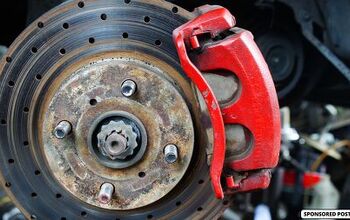The Best Car AC Refrigerants To Help You Get Your Cool Back
No matter how good your car, someday it will happen: your air conditioning system will make the dreaded switch from blowing cold air on that hot day in traffic to air that’s just cool. Then, slowly — maybe even over the course of a few days — it’ll become warmer and warmer until there’s no cooling at all.
You need that A/C, but it can be expensive at a repair shop. Fortunately, there are ways for you to recharge it yourself, and we’ve partnered with Advance Auto Parts to create a list of the best car AC refrigerant recharge bottles. Use one of these five products and you could add a few more years to the life of your air conditioning system’s ability to keep you icy cold. Then thank us later–like the next time you’re stuck in heavy traffic on a blisteringly hot summer day.
Table of contents
Interdynamics EZ Chill Refrigerant
If your AC system is low, there's a leak of some sort, and unfortunately, there's no way around that. Sometimes, though, the leak is too small to find, and in that case, a solution like this Interdynamics EZ Chill all-in-one solution can be just the trick. It has everything you need without requiring you to buy extra tools or fittings: the can comes with a gauge to let you know the status of your system and when it's full, as well as the proper fitting on the end of the hose to attach to your air conditioner. As a bonus, the gauge and dial indicator are reusable for future repairs.
Meant for R-134a cars, it also has a leak sealer and additive than can help stop small leaks in hoses, gaskets and o-rings. It replaces not just the AC refrigerant lost, but the oil that can leak from the system with it.
Pros | Comes with reusable gauges, large size |
Cons | The gauges aren't necessary if you already have some |
Interdynamics Certified A/C Pro R-134a PAG 46 Refrigerant Oil
If you've replaced a faulty part in your air conditioning system, you need to replace missing oil before you finish and seal up the system for recharging. Different parts replaced need different amounts of oil; for example, a line might not need much, but replacing your compressor could remove a significant volume. To keep those new parts working properly then, you'll need to add oil, and this is exactly the right part for many cars and trucks.
An 8 oz container means it should be more than enough for the majority of vehicle AC systems, but follow the repair instructions for both your vehicle and components replaced to make sure you're using the right amount. This refrigerant oil includes ICE 32, a lubricant additive that has been shown to improve refrigeration system reliability, efficiency and extend compressor life while reducing noise. This oil meets all specs for AC systems requiring PAG 46 oil.
Pros | Enhances AC system function and life after repairs |
Cons | This is an oil only, not a refrigerant |
A/C Pro Professional Formula Refrigerant
Because if you're refilling your air conditioner system, you're probably doing so because of a hard-to-detect leak, this refrigerant contains Max-Seal, a leak sealer that's designed to help stop leaks in the rubber components in your system. (This means tired o-rings, not a loose connection or a damaged component like a condenser.) Max-Seal also contains anti-corrosion additives that work to prevent damage caused by water that can enter your system as the result of a leak. If the refrigerant can get out, then air can get in, and atmospheric air has water in it. That water can condense inside your system, causing rust and destroying it from the inside.
Containing 10 oz of R-134a in a 12 oz container, check the repair manual for your vehicle to make sure you've purchased the right amount of product. An underfilled system won't work, but an overfilled one can suffer serious damage as a result, putting your cool plans on hot notice.
Pros | Contains leak sealant, convenient size |
Cons | Requires gauge and fill tube |
Carquest A/C Products R-134a Refrigerant
If your system had a failure, and you've had it properly drained and are planning to fix each problem, pull a vacuum to check for any possible new leaks, and then refill the system, this is the refrigerant you are looking for. That’s because it's simply R-134a refrigerant with no extra leak-stopping additives, or even oil. Use it with automotive air conditioning manifolds once you've added oil to the system to fill the refrigerant to exactly the right amount.
While many refrigerant cans are designed for one-time use, or to be sealed by an attached gauge, this one has a self-sealing valve. That means that if the vehicle doesn't need all of the product then you aren't forced to waste it by venting it dangerously (and illegally) into the air, and you don't need to leave it connected to your manifold gauge set. The threaded top is designed to work with standard AC manifolds.
Pros | Just the refrigerant |
Cons | Needs to be used with system oil and proper gauges |
A/C Pro Ultra Synthetic A/C Recharge R-134a Kit
Another convenient product that offers a charging hose and gauge, only this one has an extra-long 24-inch charging hose to make installation and dispensing safer and easier. The hose is braided to help ensure that it isn't punctured by sharp, oddly-placed, or moving parts under your hood, and it’s more than twice the length of most other options. There is also a trigger dispenser to help you control the flow of refrigerant and avoid overfilling the system.
The manufacturer says that it's been tested to deliver the coldest air from your vehicle's air conditioning system thanks to twice the cooling boosters of the next leading brand. A/C Pro Ultra Synthetic comes in a large-size can that contains approximately 17 oz of R-134a as well as 3 oz of additives that will work to help seal rubber o-rings, and seals and protect the life of the system by converting any water that gets inside to system-safe fluids.
Pros | Extra-long braided hose |
Cons | Large size could mean wasted extra product |
Why Does AC Refrigerant Leak?
Photo credit: Roman Zaiets / Shutterstock.com
The air conditioning system in your vehicle is a closed system, i.e. nothing is supposed to get in or out during the life of your ride. But, like any closed system, this relies on the weakest link. In your car or truck, that normally means a seal, like a gasket or o-ring that eventually, due to time and heat, becomes brittle and begins to let the refrigerant (often called Freon, a specific brand name) out of the system. If that happens, the system will slowly stop working until the level gets so low that the compressor -- the part that really makes the system work -- just won't turn on anymore because of safety switches that detect the low pressure.
If the system suddenly stops working when it was great the day before, there could be a more catastrophic failure at work. A rock lodged into the condenser in the grille could puncture it, while other road debris could have damaged underhood lines and components. (If one day you hear a large hiss and see a cold white cloud coming from your car, that's the most likely culprit.) The evaporator, which is usually located inside the heater box in the cabin, can also fail, allowing refrigerant into the vehicle and leaving frost on any surface it touches.
That first type of leak can often be fixed with a replacement o-ring, or by tightening a fitting. In some cases, an AC refrigerant that contains a leak sealer can revitalise the old rubber part and have you back on your way in comfort. In the second instance though, you'll need to replace components before you refill. In this case, then you'll need oil instead of just refrigerant, hence why we've included some on this list.
How to Recharge Your AC
Photo credit: Alexandru Nika / Shutterstock.com
First, check to make sure which refrigerant your vehicle uses. It should be on an underhood label and read either R-12 (found on vehicles made before the mid-1990s) or R-134a. The latter is a more modern option that is more efficient and less damaging to the ozone layer, and all of the kits on this list are R-134a. The two refrigerants are not compatible.
Most cans or gauges come with instructions, but generally, you attach the bottle of refrigerant to the end of the hose with gauge, then attach it to the low-pressure AC port under the hood of your vehicle. With the system turned on, empty the can into the system until the gauge is in the green. Then release the trigger and close the valve.
AC refrigerant is toxic, and leaks are a problem. If you recharge your system and days later it's not working again, don't just keep refilling it. That because this isn’t just expensive, it’s also dangerous to you, those around you, and to the environment. Repeated leaking means that a larger component has been damaged, or a seal or ring needs to be replaced. If you aren't able to vent the system properly -- meaning not into the air -- you'll need to take your vehicle to a service center.
Safety Note:Air Conditioning refrigerant is designed to take heat out of the air as it expands, and it will do the same thing to your skin. If you're recharging your vehicle, and refrigerant from the container gets on you, it can cause immediate and severe frostbite—even if it's 100 degrees outside. So always remember to wear gloves and take care when handling any refrigerants. The same thing can happen if there is a large system leak and you're in the way when it vents.
We are committed to finding, researching, and recommending the best products. We earn commissions from purchases you make using the retail links in our product reviews. Learn more about how this works.
Main photo credit: kryzhov / Shutterstock.com
Evan moved from engineering to automotive journalism 10 years ago (it turns out cars are more interesting than fibreglass pipes), but has been following the auto industry for his entire life. Evan is an award-winning automotive writer and photographer and is the current President of the Automobile Journalists Association of Canada. You'll find him behind his keyboard, behind the wheel, or complaining that tiny sports cars are too small for his XXXL frame.
More by Evan Williams







































Comments
Join the conversation